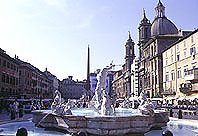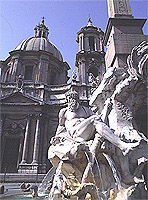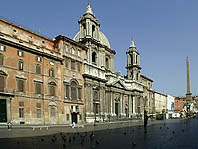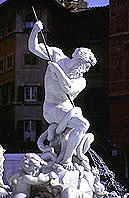Piazza Navona
Piazza Navona
 Little is square about this beautiful square-with its explosion of joyous curves. And little is otherworldly about this Papal creation. Sensuous Piazza Navona typifies Baroque Rome, with masterpieces by Bernini and Borromini. And like all the great Italian Piazzas, it has served for centuries as a glorious outdoor theater for enjoying the drama and the comedy of life.
Little is square about this beautiful square-with its explosion of joyous curves. And little is otherworldly about this Papal creation. Sensuous Piazza Navona typifies Baroque Rome, with masterpieces by Bernini and Borromini. And like all the great Italian Piazzas, it has served for centuries as a glorious outdoor theater for enjoying the drama and the comedy of life.
Typically Roman is the super-position of a Baroque pleasure area exactly over an ancient Roman monument. The 17th Century Pope, like the 1st Century Emperor, created a place of private glory as well as mob entertainment. This Piazza has been a circus for nineteen centuries and, as a pedestrian island filled with churning crowds licking their ice cream cones and having their caricatures sketched, it continues the "Roman Holiday".
The name Navona is a Medieval corruption of the Latin word for gymnastic contest: "agon "which also explains why the great Baroque church in this Piazza is called St. Agnese in Agone. If you walk out of the single exit at the North (curved) end of the piazza, and turn left, you will soon see on your left a glass-enclosed section of Emperor Domitian's original stadium (16, Piazza Tor Sanguina), and notice how much lower the ground level was in those days.
In the 17C Queen Christina of Sweden, after abdicating and becoming a Catholic (but certainly not a nun), paraded around this piazza in a highly ornate carriage - of the kind you can see in paintings at the Museum of Rome in the adjacent Palazzo Braschi.
In its earliest days, the arena could be flooded for staging mock sea battles. And a century ago it would still be covered with water in August so that the ornate carriages of the great papal families could circle around, providing a cool respite for Roman nobles and prelates who had not escaped to their country villas.
Nowadays, the Christmas season transforms this piazza into a rowdy marketplace, filled with booths, including shooting galleries and shops selling figurines for Nativity Scenes: miniature mangers with donkeys, babes and wisemen.
| Piazza Navona History 86 AD. Emperor Domitian built a long U-shaped stadium here; an arena for athletic contests, surrounded by a 15,000-seat stone grandstand, in a sparsely inhabited suburb of Rome called Campus Martius. Middle Ages. The stadium, some of whose arcades had become brothels, was adjacent to the route successive Popes took when traveling from their residence in the Lateran Palace to St. Peter's, Christendom's most important church. The original seats remained in use till the 15th Century, when sport-loving Romans came to watch jousts between brightly caparisoned knights. 1644. This was the site of a small building owned by the Pamphili family when one of its sons became Pope Innocent X. Self-glorification inspired him to transform the stadium into a beautiful square dominated by three Baroque masterpieces: Bernini's most glorious Four Rivers Fountain in the center, the highly original Sant'Agnese in Agone church he commissioned Borromini to complete as a family chapel, and the vast new Palazzo Pamphili where he installed his lady friend and sister-in-law. |
Fontana dei Quattro Fiumi
(Fountain of the Four Rivers). Along with the Trevi Fountain, this is one of Rome's most glorious designs for decorating the piazzas with the sprinkle and tinkle of water.
Here Bernini built up a sculptural wonderland of gigantic figures in the diverse environments of four of the world's great rivers, and topped it with an Egyptian obelisk. Notice that directly under the figures is an empty grotto, a mannerist architectural trick, which makes the enormously heavy obelisk appear to be floating in air.
The Nile, the Danube, the Ganges and the Plate represent the four corners of the world. The immense cost of this complicated design, involving four other sculptors who did the individual river gods, (Claude Poussin sculpted Ganges) prompted Innocent X to levy a tax on bread; so, for the rest of his life he was reviled with slogans and street signs attacking him and Olympia (whose name was distorted into "Olim Pia" the slang equivalent of "she was virtuous").
In 1651 Pope Innocent X held a contest to choose the sculptor who should crown his great piazza with a central monument. Originally, a much less elaborate fountain was to be created by the Pope's protégé, Borromini. But his arch-rival Bernini managed to steal the commission away, by getting Innocent X's not-so-innocent favorite and sister-in-law, Olympia Maidalchini, to dangle a solid silver model of this fountain before the eyes of the Pope - and then give it to him.
Fontana del Moro
(Fountain of The Moor) At the South end of the Piazza, opposite Palazzo Pamphili, Bernini added (1653) the central figure of an African cuddling a dolphin to the 1575 fountain designed by Giacomo Della Porta.
Bernini was an indefatigable designer who usually had his sketches realized by assistants. At the North end of the Piazza, the third fountain was redesigned in the 19C to match the Moro Fountain.
St. Agnese in Agone
Look carefully at the front of this church to appreciate Borromini's inventive use of rippling in-and-out curves that give depth to the thin facade he transformed (1657) into a grandiose Papal monument.
Borromini's plans always call for sober, basically white interiors, so you will be surprised by the somewhat overpowering richness you find inside. Bernini's use of warm-colored marble predominates, and he ordered the frescoes in the dome (1670-90, Ciro Ferri) and pendentives (1662-72, Baciccio).
The church's monumentality is Borromini's, its flamboyancy Bernini's. The square just lapping in all the delicious beauty.
St. Agnese in Agone History History304 AD. Wellborn 13-year old Agnes was made to strip for the clients of a whorehouse near Domitian's Arena. Thanks to her faith in Christ, Agnes' hair immediately grew long enough to hide her embarrassment. When attempts to torch her body failed, she was stabbed to death. The Church later rewarded her piety with canonization (see also St. Agnese Fuori le Mura). 1652. Pope Innocent X Pamphili commissioned Girolamo Rainaldi and his son Carlo to make him a glorified family chapel incorporating St. Agnes' much revered shrine. Perhaps he thought little Agnes' innocence would also cover up the reputation of his favorite, Olympia Maidalchini. 1653. Innocent replaced the Rainaldis with Borromini, who pulled down their front wall and designed the complex plasticity you see in the facade. He also lightened the cramped interior. 1657. A commission including Bernini took over, but did not modify the unity of Borromini's masterpiece except by gilding and sculpting and using colored marble. |
